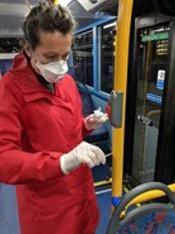The interface between microbiology and civil engineering

Aligned with our mission to advance the understanding and impact of microbiology, the Society reached out to our community of microbiologists to share their experiences in responding to SARS-CoV-2. We aim to showcase the perspective of scientists during the COVID-19 pandemic and the variety of roles adopted to mitigate the global crisis.
This case study is courtesy of Dr Lena Ciric, a Senior Lecturer in the Department of Civil, Environmental and Geomatic Engineering at University College London. She discusses her work on research projects during the pandemic, including a collaboration with Transport for London (TfL), and the associated challenges.
How did you respond to SARS-CoV-2 during the COVID-19 pandemic?
My response started in April 2020 when myself and colleagues were approached by TfL to help them protect their bus drivers. A relatively high proportion of London bus drivers lost their lives to COVID-19 early in the pandemic. TfL wanted our help to identify the measures that would be most effective in minimising driver exposure to SARS-CoV-2. Our work led to changes to the driver assault screens and bus ventilation systems. This then led to a much larger UK Research and Innovation (UKRI) COVID-19 project, VIRAL, working on reducing transmission risk to passengers on buses and underground trains. Both projects have involved working across multiple disciplines in order to answer complex questions: microbiology to detect SARS-CoV-2 and general contamination of surfaces and air; engineering to better understand ventilation systems and their impact on spread; physics to predict where droplets and aerosols might end up within the space; and computer science to allow us to identify where passengers congregate and the surfaces they touch the most from CCTV footage.

I also started work on a second UKRI COVID-19 project, AIRBODS, in February 2021. The project is focused on developing simple modelling tools that facilities managers can use to assess transmission risks in public buildings. In spring 2021, we were involved in the Events Research Programme and collected samples at Wembley Stadium and the Brit Awards. My main role is to oversee some experimental work which complements the modelling by gathering evidence on aerosol behaviour within an environmental chamber. We can control temperature, humidity and ventilation within the chamber and are running tests to see how the number and size of aerosols are impacted by environmental conditions, as well as what happens when we introduce barriers like the ones we have seen many retailers adopt.
Finally, I have engaged a lot with the media as an expert giving advice on how to minimise transmission. I have appeared on the BBC TV and radio, in a number of newspapers and have written a number of stories for the Conversation.
Was this response related to your work prior to the outbreak?
I am a microbiologist who has been working in a civil engineering department for over eight years. People are often surprised to hear this and wonder how microbiology is relevant in this context. However, civil engineering is about creating healthy environments for people – whether these are homes, workplaces, schools, entertainment venues or healthcare settings. My work focuses on infection control and how engineering solutions can be used to reduce the spread of infectious microbes, so I was perfectly placed to respond to the pandemic. Most of the work I have done in the past was within healthcare settings and I could then apply the lessons learned there to public spaces.
What were some of the challenges that you faced during this time?
I faced a lot of the same challenges as everyone else – juggling work and home schooling, anxiety about the pandemic and missing interaction with family, friends and colleagues. I was also conscious that the work I was doing would have more impact than any of the research I had done before. This was both rewarding and intimidating as our research had real consequences, whether financial or behavioural, for our research partners.
How did your experience throughout the response aid in your development?
I have had the chance to make a real impact with my research. I have had the opportunity to have my voice heard through talking to the media. I have also taken part in webinars run by the Healthcare Infection Society to translate the science of transmission to the clinical staff on the frontline. I was really proud to be able to help in whatever way I could. Our healthcare staff have been working under enormous pressure for nearly two years now and anything we can do to help is useful.
What can we learn about the importance of microbiology from the COVID-19 pandemic?
I am biased and have always thought that microbiology has an impact on all aspects of our lives. Now we have seen a virus alter the way we live in such a fundamental way. Arguably, the global population knows more about microbiology now than ever before. I think, as microbiologists, we do have to remind people that the majority of microbes are not harmful and that we and our world need many to survive and thrive.
How did the Microbiology Society play a role in your response?
The Society did not play a role in my response, but I’m delighted to have been asked to contribute a case study. The Microbiology Society did provide me with a list of the members working on SARS-CoV-2, which was useful.
About the author

Dr Lena Ciric is a Senior Lecturer in the Department of Civil, Environmental and Geomatic Engineering at University College London. Her research expertise lies in the application of molecular biology techniques to the profiling of microbial communities in various environments, including public spaces.
